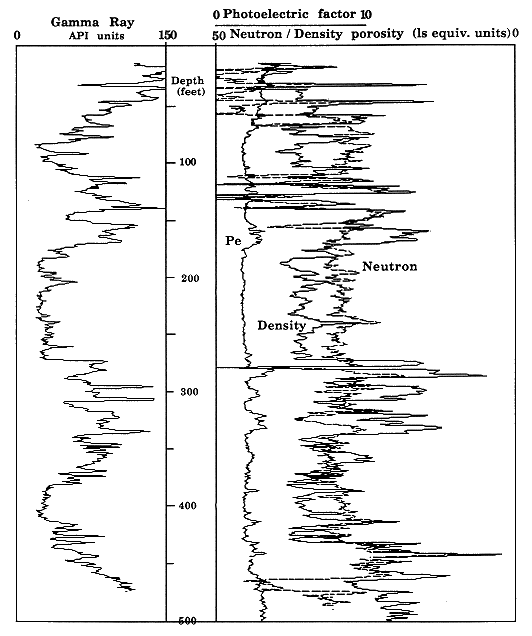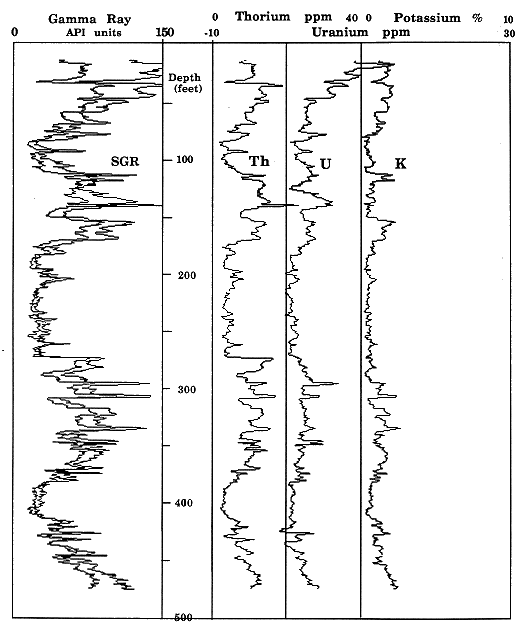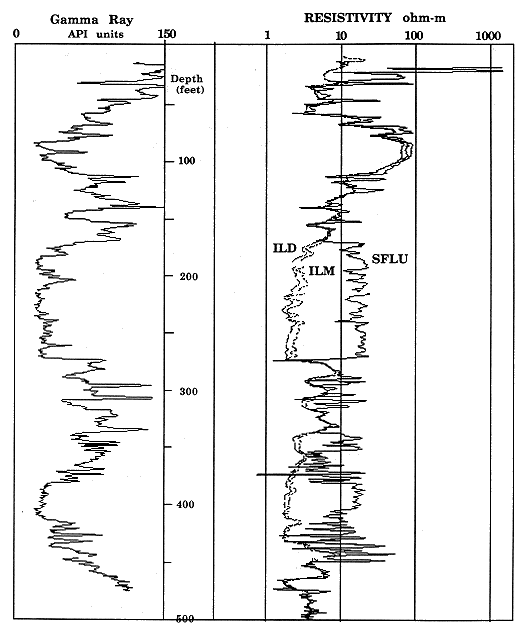



Kansas Geological Survey, Open-File Rept. 91-1a
Pre-Graneros Paleogeography--Appendix 3
The KGS #1 Jones test hole was drilled during May, 1990, in NE, NE, NE Sec. 2, T. 10 S., R. 8W., Lincoln County, Kansas, on land owned by Larry Jones. The test hole began in the lower part of the Greenhorn Limestone [upper 14.5 ft (4.4 m)] at the top and ended in the Permian Ninnescah Shale at a total depth of 506 ft (154 m). Figures 3.1 through 3.4 show the geophysical logging traces from the borehole. A detailed description of the core retrieved and its interpretation is given in what follows.
Figure 3.1. Gamma-ray and caliper logs of KGS Jones #1 NE-NE-NE 2-10S-8W indexed with stratigraphic subdivisions.

Figure 3.2. Gamma-ray and lithodensity-neutron logs of KGS Jones #1 NE-NE-NE 2-10S-8W, Lincoln Co., KS.

Figure 3.3. Spectral gamma-ray logs of KGS Jones #1 NE-NE-NE 2-10S-8W, Lincoln Co., KS.

Figure 3.4. Gamma-ray and resistivity logs of KGS Jones #1 NE-NE-NE 2-10S-8W, Lincoln Co., KS.

14.5-59 ft (4.4-18 m) (Graneros Shale interval)
This interval consists of a medium- to dark-gray finely laminated, fossiliferous, calcareous silty shale that grades downward into a dark-gray blocky, fossiliferous, calcareous silty shale with interbeds of bentonite and sandy fossiliferous siltstone containing wavy laminations and hummocky (?) cross-stratification. Beds consisting of broken shell remains and fish teeth and lenticular interbeds of fossiliferous, very fine grained silty sandstone with hummocky cross-stratification and wavy laminations occur near the middle of the formation.
The Graneros Shale was deposited in an offshore shallow marine setting below normal wave base but above storm wave base. The presence of hummocky cross-stratification and fossil debris in the lenticular sandstones indicates that the sea bottom was periodically agitated by storm waves.
59-112 ft (18-34.1 m) (Uppermost Dakota Formation)
A coarsening-upward sequence of fossiliferous and bioturbated, medium- to fine-grained, moderately well-sorted sandstone containing clay clasts, glauconite, and pyrite and interbedded silty shales and siltstones comprise the upper part of this section of the core. Fossils include molds and casts of whole and fragmented mollusk shells, shark teeth, and fish remains. The interbedded silty shales are dark gray and laminated and show evidence of bioturbation, although no burrows were identified. A basal scour is at the base of this core section. These deposits were most likely deposited in a distal bar seaward of a river-dominated delta and signal a rise in sea level resulting in inundation of the delta.
Below the distal bar deposits, coarsening-upward sequences of mostly fine-grained, moderately well-sorted sandstone alternate with bioturbated, interlaminated, very fine grained, silty sandstones and siltstones. The sandstones are wavy laminated to asymmetrically rippled with carbon flakes, plant debris, and mica flakes along bedding surfaces or horizontally to crossbedded with rip-up clasts and carbonized plant debris on bedding planes. Skolithos burrows are common in the bioturbated silty sandstones. Carbonized plant remains and layers of shaly lignite with roots in place extending down into underlying units are also present in this interval. These strata were deposited as part of a sequence of events beginning with the formation of crevasse splays in an interdistributary bay and eventual filling with mud and colonization by land plants. The coarsening-upward sandstones and interlaminated siltstones and sandstones are crevasse splay and bay fill sediments, respectively, that were deposited in an interdistributary bay environment; the lignites are from accumulations of plant material in swamps or boggy areas and represent the final filling of an interdistributary bay.
112-154 ft (34.1-46.9 m)
This part of the core consists of a sequence of sandstone, gray siltstone, and shale that generally fines upward. The sandstones range from medium to very fine grained and are typically carbonaceous. Bedding in the sandstones is generally absent, except for some crossbedding at the base of the interval. Otherwise the strata appear to have been compacted and slumped. Clay clasts and carbonized plant fragments are abundant, especially near the bottom of this section. Scour surfaces are preserved in the lower, more sandy part of this section and at the bottom of this sequence. In the upper part of this section fine to very fine grained sandstone is interbedded with siltstones, silty shales, and carbonaceous shales. Leaf impressions preserved on bedding plane surfaces in silty and clay shales are common. Pyrite is a common accessory mineral in the shales, whereas pyrite and siderite nodules are abundant in the gray siltstones.
This part of the core is interpreted as the fill of an abandoned distributary or river channel on a coastal plain. This interpretation is based on (1) the generally poor sorting of the sediments filling the abondoned distributary, (2) evidence of slumping of the sediments as a result of compaction of the organic debris and clays, and (3) the erratic nature of vertical changes in sedimentary texture within the sequence.
154-183 ft (46.9-55.8 m)
Interbedded to interlaminated, light-gray, silty sandstones and dark-gray, clayey siltstones predominate in the upper part of this interval. Some of the beds appear to have slumped after deposition. The siltstones grade downward into gray massively bedded, silty shales with slickensided surfaces. Below, gray and gray green massive to indistinctly bedded siltstones with lenses of interlaminated very fine grained sandstone and siltstone predominate. At many levels in the core there is low angle (5(-10() crossbedding and poorly preserved scours. In situ roots were found near the middle of this interval. In the lower part gray siltstones grade downward into fine to very fine grained, well-sorted sandstone that is ripple to horizontally laminated and interbedded with layers of gray siltstone. At the bottom of this interval the siltstones are interbedded with a silty sandstone. Pyrite nodules, carbon flakes, and distinct zones of siderite nodules are common.
This part of the core is interpreted to have been deposited by fluvial processes in a flood-plain environment away from a meandering stream. This interpretation is supported by (1) the abundance of fine-grained clastics, (2) limited evidence of scouring by moving water, suggesting a low-energy environment, (3) the sporadic occurrence of interlaminated, very fine grained sandstones and siltstones and ripple laminated sandstones within a gray siltstone lithofacies, suggesting periodic flooding, and (4) the presence of in situ roots and the vertical gradation of siltstones into silty clays, suggesting soil development. The ripple to horizontally laminated sandstone may have resulted from the development of a crevasse near the site of deposition. The gray color of the whole sequence suggests that the soils were not well drained and were probably near the water table, perhaps in a coastal plain environment.
183-273 ft (55.8-83.2 m)
Sandstone with occasional zones containing clay intraclasts was recovered in this interval and is presumed to be the predominant lithology in this interval from the trace of the gamma ray log of the test hole. The degree of sorting and grain size varies from well sorted and fine grained to poorly sorted and medium to coarse grained. Bedding ranges from indistinct or massive to horizontal to cross-stratified. Mica flakes are abundant throughout this part of the core, but plant fragments and wood chips are found only in the more poorly sorted parts of the core. Mud drapes and fining-upward sequences are readily identified using the core and gamma-ray log.
The variation in sandstone grain size and sorting and the fluctuations of the gamma-ray curve in this interval suggest that this unit is a multistoried channel sandstone body that was deposited in a fluvial environment. On the basis of the core, there appears to be an increase in grain size and a decrease in sorting downward from the top of this multistoried body. The bedding also changes from horizontally bedded near the top to crossbedded near the bottom. The poorly sorted, coarser sandstones probably signify diminished competency under higher energy flow regimes, whereas higher up the horizontally bedded, better sorted, finer grained sandstones signify more stream competency but lower stream power.
273-334 ft (83.2-102 m) (Longford Member, Kiowa Formation)
Below the Dakota-Kiowa Formation contact, the uppermost part of the Kiowa consists of an unusual sequence of alternating red- and yellow-mottled, gray siltstone and bioturbated, fine to very fine grained sandstone. Within each siltstone unit, red- and yellow-mottled sections occur near the top and possibly contain root holes stained with red. Portions of the siltstone units are sandy or clayey. Siderite nodules are abundant in the unmottled gray siltstones. Each sandstone portion of the sequences generally coarsens upward from very fine to fine-grained and even medium-grained sandstone. The sandstones have been extensively bioturbated, leaving in many cases no evidence of the original bedding. Broken laminae and Skolithos and Arenicolites traces are common in sandstone along with fluid-expulsion structures, and slump features caused by compaction of high-water-content sediments are also common. Clay intraclasts of varying size occur sporadically in well-sorted, fine-grained sandstone. Carbon flakes on bedding planes and carbonized fragments and wood chips are also present. Ripple to wavy laminated sandstones occur near the middle of this section of the core and show no evidence of bioturbation. Scours and low-angle bedding ((5() occur sporadically in this section.
This alternation of sandstone, gray-mottled siltstone, and eventually red-mottled gray siltstone is part of an overall progradation of deltaic deposits into the Kiowa sea that at times was sufficient to keep up with rising sea level but at other times was overtaken and submerged. The gray siltstones were deposited during periods of nonmarine deposition on a natural levee or coastal plain adjacent to the shoreline. The red mottling near the top of each gray siltstone implies that initially deposition occurred in wet areas, that gradually became drier with time, such as near the boundary between the intertidal and supratidal zones in an estuary. The sandstones were deposited in shallow, subaqueous brackish-water tidal sand ridge complexes on the tidal plain. At times the influx of sediment must have been great enough in the lower sandstones that a burrowing fauna could not remain established. Rapid deposition is also indicated by the occurrence of water-expulsion and slump structures in the silty, very fine grained sandstones.
334-430 ft (102-131 m)
The upper portion of this section consists of well-sorted, medium- to fine-grained sandstone interbedded with interlaminated, silty shale grading upward into interlaminated sandy siltstone. The sandstone is high-angle cross-stratified (10°-19°) near the bottom but becomes rippled and horizontally laminated and wavy bedded above. Carbon and mica flakes are commonly concentrated along bedding planes. Clay intraclasts were noted at several levels and along with a scoured surface at one level. Bioturbation is sporadic in the sandstones, but specific traces could not be identified. The interbeds contain lenses of sandy siltstone (linsen) near the bottom and grade upward into bioturbated interlaminated siltstone and fine to very fine grained, well-sorted sandstone.
In the middle portion silty, poorly sorted, medium- to coarse-grained sandstone grades upward into well sorted to moderately well sorted, medium- to fine-grained sandstone. High-angle crossbedding (20°) is common throughout except near the bottom where occasionally the dip is less, approximately 10°-15°. Ripple laminations are present throughout, and horizontal bedding is rare. Clay intraclasts seem to occur where there is a change in overall grain size. Carbon flakes are ubiquitous in the upper part, but carbon fragments and carbonized wood chips are more common in the lower part. Above a well-preserved scour near the base is an intraformational conglomerate that consists of sandstone and siltstone clasts ranging in size from granule to cobble in a mud matrix that appears to be chaotically bedded. Below the conglomerate is a fine-grained sandstone interbedded with layers of silt with linsen of fine-grained, silty sand. The sandstones display a wide variety of bedforms in core, ranging from horizontally and wavy bedded to asymmetric ripple laminated to cross-stratified (10°-22°). The finer grained interbeds show a progressive upward change from silty shale with rare lenses of silt near the bottom to sandy siltstone with lenses of fine to very fine grained sandstone near the top of the section. Occasional zones of clay clasts are common throughout this section, ranging up to pebble size. Carbonized plant fragments are common near the upper bounding unconformity but are absent below. However, carbon flakes are common throughout. At the base of this interval is a scour that underlies an intraclastic conglomerate that is mud-matrix supported.
The trace of the gamma-ray curve from the middle of this section to the base of the Cretaceous shows the classic coarsening-upward pattern suggestive of a deltaic or offshore barrier bar environment. However, from the core the evidence is more suggestive of a vertical succession of lithofacies commonly found in a tidally influenced deltaic environment. The well-preserved basal scours and associated intraclastic conglomerates and multiple superimposed fining-upward sequences of sandstone probably mark the shifting channels of flow, and the wide diversity of primary sedimentary structures that show little regularity vertically are characteristics frequently associated with estuarine distributary deposits. In addition, the intercalated, finer grained sediments with linsen bedding are indicative of intermittent slack periods of flow with mud deposition and little sand input, such as in a tidal environment.
430-444 ft (131-135 m)
This section of the core consists of (1) a carbonaceous and glauconitic, well-sorted, fine-grained sandstone with thin interbeds and laminations of siltstone that grades downward into a very fine grained sandstone near the bottom of this section and (2) a chaotically bedded, carbonaceous, very fine grained, silty sandstone and siltstone above the base. In the uppermost part the sandstones are current ripple laminated to wavy bedded, contain abundant plant fragments and granules of glauconite, and show some evidence of disturbance from either slumping or bioturbation. The lower part is heavily bioturbated and has a high organic matter content. Carbonized plant fragments and wood chips are abundant in the upper part but not in the lower. Multiple scours are also abundant in the upper part but not in the lower. However, clay intraclasts occur throughout this section.
Strata in this part of the core are interpreted to have been deposited in a brackish river mouth bar environment or marine offshore bar near the mouth of a river. The presence of glauconite, wavy laminations, scours, and the clean, well-sorted nature of the sandstones suggest deposition in an environment with slow sediment accumulation and frequent winnowing by currents and waves. The subjacent position of this part of the core to the overlying distributary sands, the abundance of plant fragments and wood chips, and the degree of bioturbation imply that the site of deposition was proximal to a prograding deltaic environment in a distal bar.
444-463 ft (135-141 m)
From the top down this part the core consists of (1) a wavy interbedded, fine-grained sandstone and siltstone grading downward into an interlaminated, very fine grained sandstone and gray siltstone, (2) a fine-grained, silty sandstone with in situ roots that grades downward into a bioturbated, very fine grained, silty sandstone, and (3) a wavy to ripple laminated, interbedded, very fine grained, silty sandstone and siltstone. In the upper unit, 1, the sandstone interbeds range in thickness from 2 in.-2 ft (0.8 cm.-0.6 m) and are slightly bioturbated. High-angle crossbedding occurs at the bottom of this sequence. Carbon flakes occur primarily on bedding planes in the sandstones. The contact with the vertically adjacent siltstone units is conformable. The interlaminated, very fine grained sandstones and gray siltstones do not appear to have been disturbed by burrowing organisms. The middle unit, 2, shows extensive evidence of disturbance by organisms, including burrows and broken laminations. In situ roots extend at least 2 ft (0.6 m) below the top of this unit. The only primary sedimentary structure found in this section of the core was horizontal bedding consisting of infrequently occurring, finely laminated, sandy siltstones. Loading and soft sediment deformation structures were also observed. A scour was noted near the bottom of the middle unit. Scattered carbonized plant fragments and carbon flakes are common. In the lower unit, 3, interbedded siltstone and very fine grained, wavy laminated sandstones and siltstones grade downward into bioturbated sandy siltstone. Broken laminations and a "patchiness" to the sedimentary texture suggest extensive disturbance by burrowing organisms. Within the interbedded portion, scours and "erosional ripples" are well preserved. A possible slump feature was noted near the base of the section.
The strata in these three subunits were probably deposited in a tidally influenced upper shoreface and beach or tidal sand ridge environment in the vicinity of a prograding sequence of delta deposits. In the middle subunit the presence of roots in a bioturbated sandstone suggests subaerial exposure of highly bioturbated marine or brackish-water deposits. The interlaminated, silty sandstones signal inundation of the beach environment by the Kiowa sea and a return to the shoreface environment in the upper subunit. In units 1 and 3, the interlaminated silty sandstones and the primary sedimentary structures suggest low-velocity currents with slack periods, such as in a tidally influenced environment.
463-474 ft (141-144 m)
This part of the core consists entirely of finely laminated, black, clay shale and gray silty shale. The shale is black in the upper part and grades downward into medium-gray shale in the middle where it is interbedded with siltstone and very fine grained, silty sandstone containing glauconite and carbonized plant fragments. The sandy siltstone layers are laminated and wavy bedded. Below, the shale grades into black and then greenish-brown clay shale containing carbonized plant fragments near the bottom. Just beneath the interbedded section fragments and whole bivalve shells were found in shale along with abundant carbon flakes. The contact between this section and the underlying Permian green siltstone is sharp, and just above the contact the shale becomes silty with some sand grains.
The black shale in this section belongs to the marine shale facies of the Kiowa Formation. Its marine character is indicated by the fossil content, the finely laminated shales that accumulated under relatively quiet-water conditions, and the wavy laminated, glauconitic, sandy siltstones that may have accumulated as storm depsits. The base of this section is interpreted to be the Cretaceous-Permian boundary.
Start of this report || Table of Contents